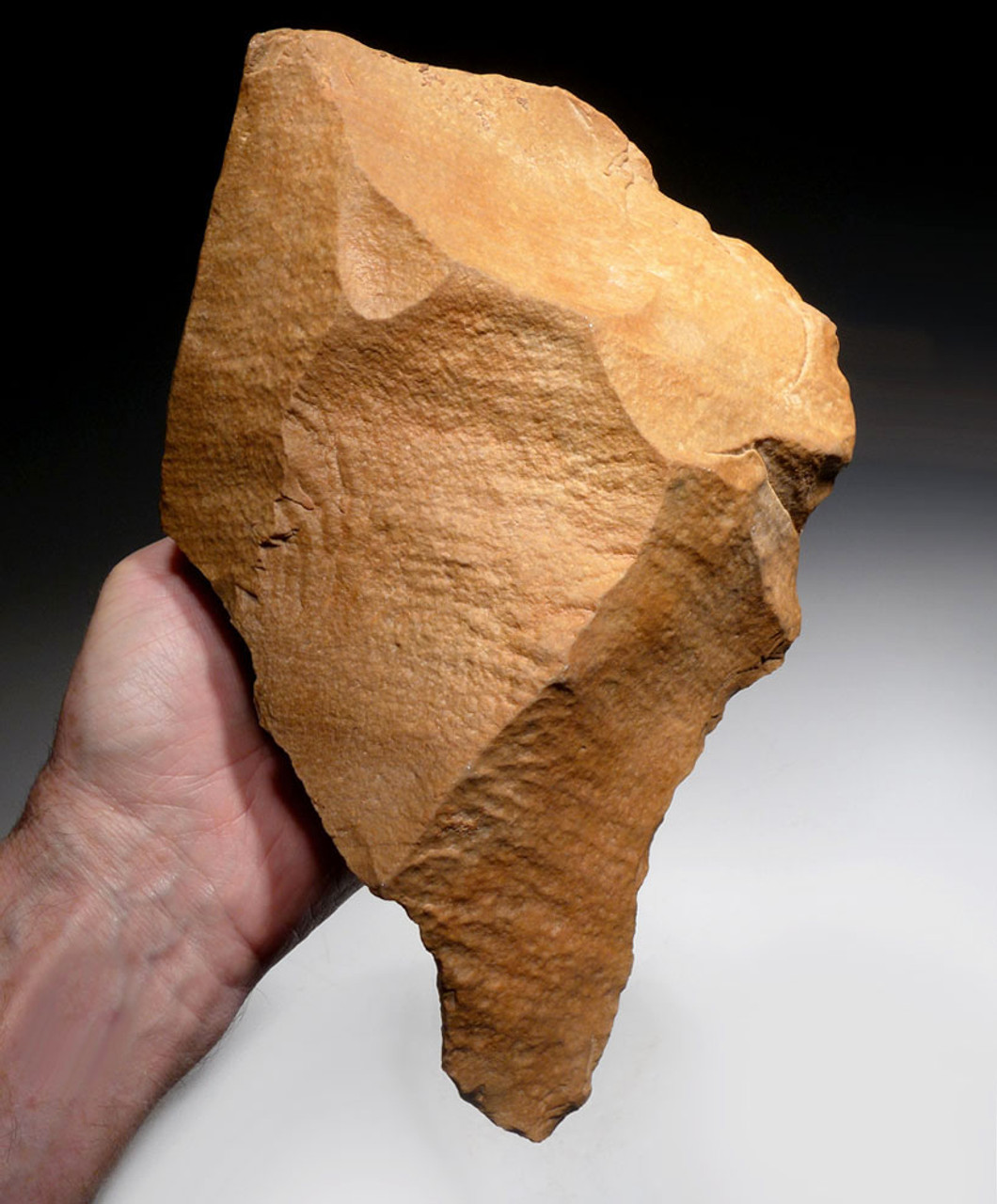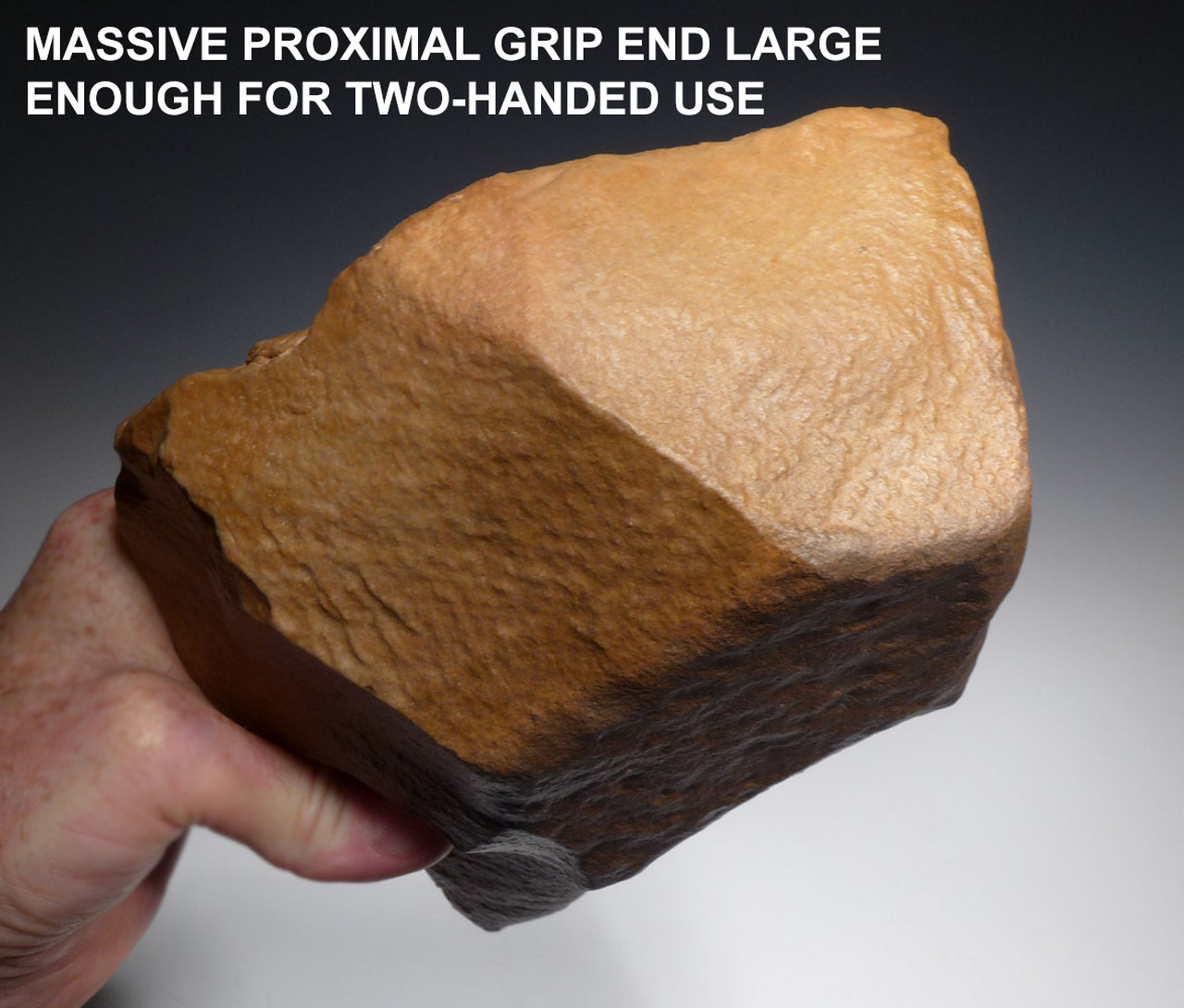Product Description
SEE MORE LOWER PALEOLITHIC ACHEULEAN STONE ARTIFACTS
This GENUINE Acheulean hand axe was made and used by early humans of the primitive species Homo erectus (ergaster). It was surface-collected from an exposed Lower Paleolithic Acheulian site in the Sahara Desert of Northwest Africa. Acheulean Lower Paleolithic hand axes from Africa represent the first scientifically documented intelligent tool made by primitive humans. Prior to these Saharan Acheulean handaxes, only crude pebble and flake tools existed in the human fossil record.
Where do we begin describing something that is so impressive that in 22 years of extensive experience in the field, it has no comparison? Giant Acheulean hand axes from Africa are known but they are very, very few in number. An example of this magnitude first off, has what purpose? At a weight of 8 pounds (3.6 kilos), it certainly is not something that Homo erectus would just pick up with one hand or even need to butcher even the largest game animals. Could these have been the ultimate prestige pieces - humans' first form of art to appreciate? Could they have been made as objects of worship or ritual? No one knows but an African Acheulean hand axe of this size and weight was not easily wielded by the primitive humans of the day. We have a theory, though. In this period of time in northern Africa where this hand axe was found, large game animals were hunted such as elephant, bison, rhinoceros, giraffe and hippopotamus. Even with a band of hunters cooperating, taking down one of these deadly beasts was no easy task with wooden pole spears and stones. In the hunt, it is certain many hunters died or were seriously injured, but the reward of the great resources that came from such a kill would have been worth the risk. Because of the weapon technology of the time, it is probable that these animals were most often only injured and not killed swiftly. We believe massive two-handed stone hand axes such as this example, would have been used by a brave hunter to approach the downed beast and kill it with a final crushing blow to the skull. What else would put an elephant or hippo down when you are armed with wood spears?
If our theory is correct, then that explains the sheer rarity of a specimen such as this - only one was needed for an entire hunting party. It is also likely they were kept and reused rather than discarded like most hand axes since making such a massive size stone axe was a chore unto itself in the Lower Paleolithic. This would explain the workmanship that goes way beyond what would have been needed for normal utilitarian purpose. These axes were highly prized, cherished and INVALUABLE to hunting these large game animals. Perhaps they were even worshipped. Whatever the thought, one cannot discount the fact that of the few giant-sized Acheulean hand axes known from the Sahara, all are made with extremely high levels of skill and care, displaying artistic workmanship that only the highest level of master stone tool maker could achieve.
What we do know in this specific hand axe is that it possesses extreme weight, concentrated in the head of upper area of the axe such that the thickness is larger than any other example we have ever seen. The tip is another story with a very thin, narrow profile that would have been ideal to pierce and puncture even an elephant skull with a single overhead, two-handed blow. Think of this hand axe like a massive pile driver. Its function would have specifically to puncture and crush, not cut or slice.
Special features of this hand axe are worth noting. It displays a glossy, dark "desert varnish" wind-polished patina only on one side where it lay undisturbed and exposed to blowing sands, for hundreds of thousands of years. The other side is dull as it lay face down, protected and laying directly against the red Saharan sand. This accounts for the redder color on this side. Every original flaked aspect of this specimen is perfect as made with no modern damage including an original, unbroken delicate tip. Prehistoric sediment and mineral encrustations are still present in microscopic crevices and on some surfaces - traits ONLY found in authentic Paleolithic artifacts like this. These features are a testament to the age and authenticity of ALL Saharan Paleolithic artifacts.
To date, THIS IS THE ONLY HAND AXE OF THIS MAGNITUDE AND CLASS we have ever offered. It is the type of Stone Age prize artifact that you find maybe once in a lifetime and never forget it. It takes two hands to even hold it and to experience it in person is something that no words can describe. Genuine Saharan Acheulean hand axes of this quality are rare and recent realized prices at major auction houses are proving what we have been saying for years that authentic high grade tools of primitive man remain one of the most promising investments. Specimens like this are one in many, many thousands and are exceptionally rare. Collectors consider prized features to include either size, workmanship or color but when ALL exist, then it is truly an important piece to include in a collection as this one is.
HISTORY
During this time in prehistory when this Lower Paleolithic tool was made, the Sahara Desert (where this stone tool was found) was a savanna rich in wildlife. Prior to the prehistoric global warming that turned the vast region to desert, early humans lived alongside prehistoric giraffe, bison and elephant, which were vital to their survival. Hunting and butchering these animals would have required specialized tools such as those found in the Acheulian Period.
 US DOLLAR
US DOLLAR
 EURO
EURO
 AUSTRALIAN DOLLAR
AUSTRALIAN DOLLAR
 CANADIAN DOLLAR
CANADIAN DOLLAR
 POUND STERLING
POUND STERLING




























